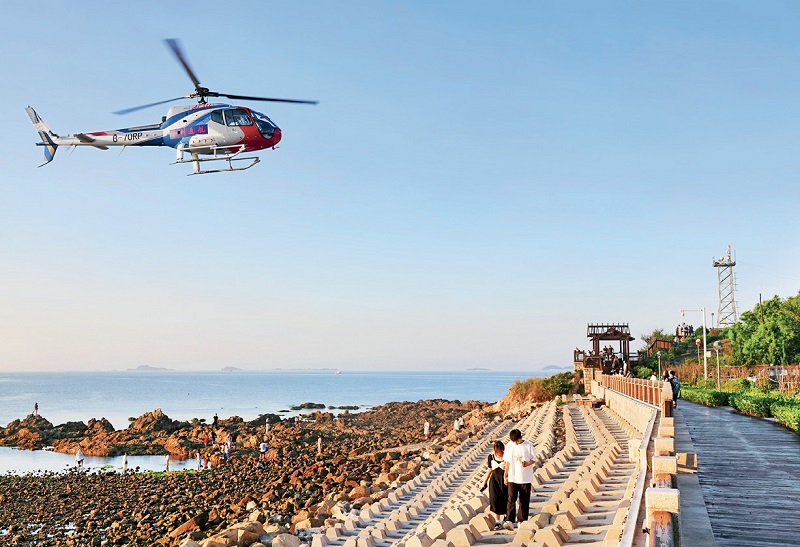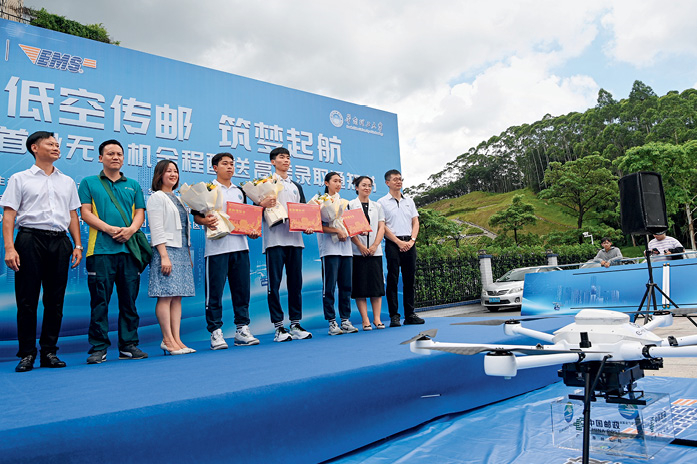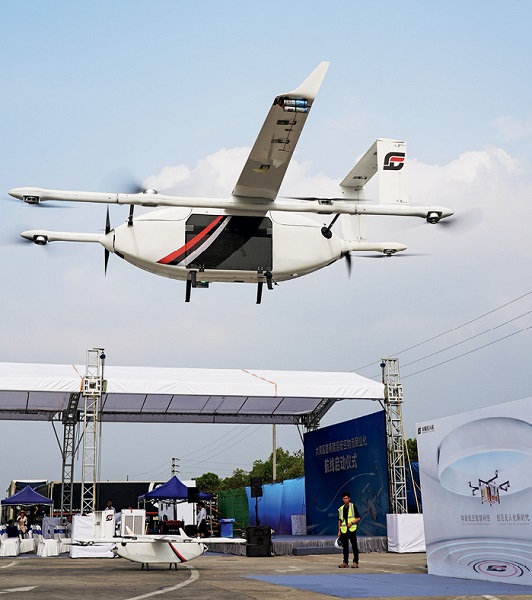High technology boosts the efficiency and safety of low-altitude aerial services while reducing pollution.

An AC311 helicopter carries tourists over a beach.
Around 11.30 AM on a sunny day in July 2024, four students participated in a ceremony in Huangpu, a district in the city of Guangzhou, Guangdong Province, in southern China, in which they received drone-delivered packages. It was the herald of China’s postal service making history, jumping from snail mail into the ranks of drone delivery. The four students had been sent letters in distinctive red envelopes by the South China University of Technology in the city, informing them that their application for admission had been accepted.
It was the first delivery of college admission letters by drone, Zou Liwen, general manager of the Government and Enterprise Center of China Post’s Guangzhou branch, said at a press conference later. With the success of the pilot service, China Post will make low-altitude drone delivery part of their air, rail, and road transportation networks to expand their reach.
From logistics to agriculture, from surveys and mapping to power grid inspection, and from light shows to aerial photography, today unmanned aerial vehicles (UAVs) are being used for various purposes and in different sectors. The trend can be traced back to 2010, when China launched a reform of low-altitude airspace management to tap more aerial resources. It unleashed a wave of technological innovations and applications throughout the industrial chain which led to a boom in low-altitude industries. This March, the term “low-altitude economy” appeared in the government work report and went viral. Now local governments around the country are exploring the new opportunities it offers.

Li Shipeng, executive director of the LASER Institute of International Digital Economy Academy and an academician of the International Eurasian Academy of Sciences.
Trillion-Yuan Market in the Pipeline
According to Li Shipeng, executive director of the LASER Institute of International Digital Economy Academy (IDEA), the factors behind the rise of the low-altitude economy are the progress in traditional technologies, such as those for radio, communication, navigation and surveillance, and the rise of new industries, such as the Internet of Things and artificial intelligence. “Today, we can use existing technologies to digitize the entire low-altitude space into a computable space … where we can compute intelligently, plan routes and airspace optimization, and monitor aircraft real-time, which is an important guarantee for the development of the industry,” Li said.
Earlier this year, the Ministry of Industry and Information Technology and three other central government departments issued a plan for the innovation and application of general aerial equipment for the 2024-2030 period. It says by 2030, the general aviation industry will be developed intelligently and in a green way and general aviation equipment will be widely used in people’s daily work and life, creating a trillion-yuan market.
This year has seen several developments. In February, Prosperity, a five-seater electric aircraft which is capable of taking off and landing vertically, and was developed by AutoFlight, a Shanghai-based hi-tech startup, conducted the world’s first inter-city air taxi demonstration flight. It took off from a port in Shenzhen in Guangdong and landed at another port in Zhuhai, another city in the province, in 20 minutes, compared with three hours by car. The air taxi service is expected to start in 2026.
In June, at a promotional event for local cherries in Tianshui, Gansu Province, courier and logistics company SF Holding tested its ARK-40 cargo drone. The company says the drone can collect and transport cherries in mountainous areas and other complex terrains, cutting transportation time by half. Such services will boost the modernization of the agricultural industry.
China’s low-altitude economy has more than 57,000 players, with 21,000 of these companies started during the past five years, according to the Research Report on the Development of China's Low-Altitude Economy (2024) released by the China Center for Information Industry Development.

An unmanned drone delivers four admission letters from the South China University of Technology in Guangzhou, Guangdong Province in south China, on July 15, 2024. The flight took 40 minutes.
Security Concerns
While the developments indicate that countless flying machines may be shuttling back and forth in the sky in the not too distant future, there are also questions about safety and security.
Li is optimistic. “Compared to high-altitude flights, low-altitude flight routes take more factors into account, such as avoiding crowds, dense buildings, and historical sites,” he said. “In emergency situations, a large number of aircraft can quickly veer to a new route.” Besides, the current motor and battery technologies are mature and many aircraft have backup components to ensure safe landing in case of mechanical failures.
To manage low-altitude aircraft, the aviation authorities need to know their location so that they can be given instructions in case of problems. This is crucial for the safety of the entire airspace. For this, equipment is needed to track the aircraft but the traditional large radars for large vehicles are not suitable for small aerial vehicles flying at low altitude and speed.
Efforts are being made to find a substitute. Experiments are being conducted to project part of communication frequency bands or radio waves into the sky so that they reflect off the small vehicles flying at a low altitude back to a receiving antenna.
Logistics and food delivery are among the fields where unmanned drones are used most. Meituan, China’s leading e-commerce platform, stands out for its use of unmanned drones, having completed 250,000 drone deliveries by the end of March this year. Its drones use cameras, which while key to the success of the flights, also raises privacy concerns.
This issue can be resolved by setting proper standards and requirements for aerial vehicles, Li said. "Meituan has introduced privacy protection measures for its drones. The function of the front camera is limited to detecting obstacles, showing only image structures without revealing real scenes, while the downward-facing camera is used only to scan a QR code on a locker for parcels at the destination,” he explained.
Consumer service drones mainly operate in the space 0-120 meters above the ground, with a maximum height of about 40 floors. In order to minimize sound pollution, Meituan has refined the propeller design and route planning. Instead of flying over the building where the customer lives, its drones descend vertically to a site nearby, and then slide to the designated parcel locker. In this way the noise is greatly reduced.
As the low-altitude economy grows at full throttle, many technologies are being experimented with and improved for their practical application. "Research and development will make these technologies safer and more efficient," Li said.

The first commercial sea-crossing low-altitude air route in the Guangdong-Hong Kong-Macao Greater Bay Area is launched at a logistic park in Zhongshan City, Guangdong Province, on April 12, 2024.
Machine vs. Man
Chinese tech company Baidu’s driverless robotaxi Apollo Go began operating in Wuhan in central China in March. It is said there are about 500 of them in the city, with plans to double the number by the end of the year. This has raised concern that the service might push human cab drivers out of business. Li thinks public alarm is normal in the early days of the application of a technological innovation due to insufficient understanding of how it works. "This reminds us that in the process of exploring low-altitude airspace resources, we need to provide scientific guidance to the public," he said.
According to him, the biggest obstacle to autonomous driving is the uncertainty about people and other cars. There is a view that it would be safer if the vast majority of automobiles on the road were self-driving, as they would all follow planned routes. This is exactly the case in the low-altitude airspace. "The vast majority of aerial vehicles are unmanned, and safety in the low-altitude space can be enhanced through effective overall planning," Li said.
According to a report on the development of China's low-altitude economy, China’s low-altitude economy reached RMB 505.95 billion in 2023, marking an annual increase of 33.8 percent. This remarkable growth was primarily driven by the manufacturing of aerial vehicles and low-altitude flight services. However, the potential of low-altitude infrastructure and flight support services is yet to be fully unleashed.
In Li’s opinion, more attention should be paid to infrastructure and supporting services. "Industry leaders such as Meituan and SF have built infrastructure to run their respective routes, maintain their airspace, and provide navigation support. The problem is that their infrastructure is for their exclusive use," Li said.
To improve communication and coordination among the drones of different companies, he has two suggestions: Enterprises should continue to accelerate scientific and technological innovation to promote industry-wide progress; and the government should take the lead to establish a unified management platform, encouraging enterprises to share infrastructure, integrate databases, and formulate rules. This will ensure unified planning and management in the sector.
Shenzhen is a pioneer in this. It is working on an infrastructure network, an air-ground network, an air route network, and a service network that will cover the entire city. At the core of these networks is the smart integrated lower airspace system, which was developed by IDEA. A new type of infrastructure, it will provide technology for effective, targeted management by air traffic control authorities and provide drone operators safe, reliable, efficient, and intelligent services. This will help Shenzhen's low-altitude economy to scale up and achieve sustainable, high-quality development.
Guangdong, being part of the Guangdong-Hong Kong-Macao Greater Bay Area singled out for development, enjoys many preferential and supportive policies and strong institutional support from the state. It began to build a three-dimensional transportation network years ago, and the developed economy, robust manufacturing bases and many innovation centers in the region have laid solid financial and technological foundations for the low-altitude industry.
According to data released at a provincial conference on the high-quality development of low-altitude economy in July, Shenzhen has more than 1,700 enterprises engaged in the low-altitude industry. Last year the output value of the city's low-altitude economy exceeded RMB 90 billion, and it led the world in the number of unmanned drone flights (610,000) and helicopter flights (23,000).
Li, who is also an adjunct professor at the Chinese University of Hong Kong, Shenzhen and the Hong Kong University of Science and Technology (Guangzhou), said the regional government of Hong Kong places great emphasis on the low-altitude sector and hopes to deepen cooperation with the mainland. The HKUST maintains close exchanges with its mainland counterparts.
"China will lead the development of the low-altitude economy in the world," Li said, predicting that in 10 years about one-tenth of ground transportation will move to the air. This will trigger a 50 percent increase in operation and other business activities and lead to vigorous growth of related industries.